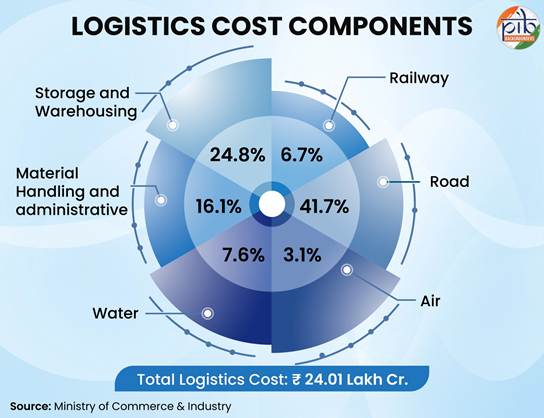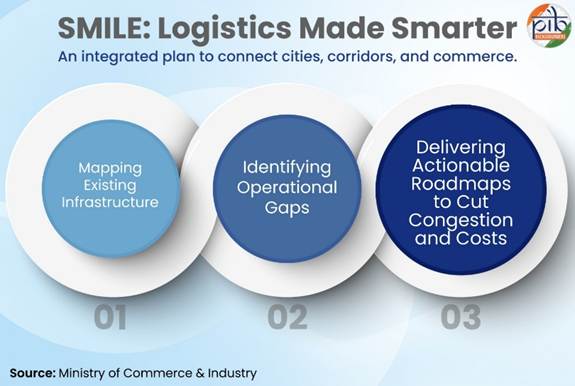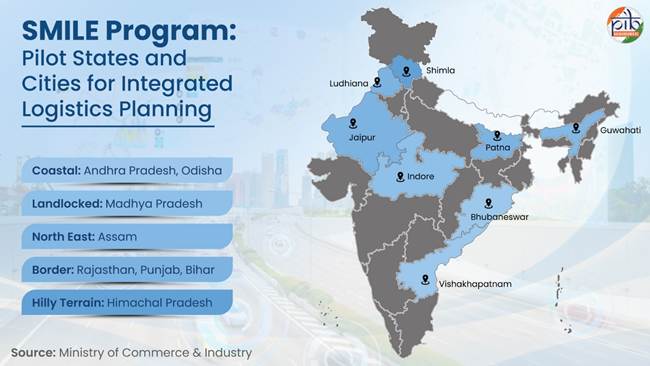PIB Headquarters
From Growth Engine to Global Edge: Supercharging India’s Logistics
Posted On:
27 NOV 2025 9:54AM by PIB Delhi
- India's logistics cost has dropped to 7.97% of GDP.
- IPRS 3.0, developed with the Asian Development Bank, rates industrial parks on sustainability, green infrastructure, connectivity, digital readiness, and skills.
- The SMILE program launched logistics plans in 8 pilot cities across 8 states to assess existing logistics infrastructure and improve efficiency and reduce costs.
A New Chapter in India’s Logistics Story
India’s logistics is entering a new phase and converting itself into a faster, smarter, and globally competitive sector. From integrated digital platforms that streamline freight movement to modern infrastructure connecting every part of the country, a next-generation logistics ecosystem is steadily taking shape. Backed by targeted policy reforms, institutional realignment, and technology-driven solutions, the government is transforming logistics into a key driver of India’s economic growth and global trade positioning.
A wave of structural changes is reshaping how logistics is planned, executed, and scaled across the country. Platforms like ULIP (Unified Logistics Interface Platform) are integrating data across departments, while LDB (Logistics Data Bank) 2.0 enables real-time visibility of millions of containers. Every HSN (Harmonized System of Nomenclature) code is mapped to its line ministry, improving accountability and policy design. Logistics plans at the city and state levels under the SMILE (Strengthening Multimodal and Integrated Logistics Ecosystem) programme are being aligned with national priorities. Inland waterways transported a record 145.84 million tonnes of cargo last year, while rail congestion is being addressed through dedicated freight corridors. In industrial zones, plug-and-play parks under NICDC (National Industrial Corridor Development Corporation) offer ready infrastructure for investors. On the ground, reforms such as GST and the e-Way Bill have removed long-standing frictions in interstate transport. These interventions are driving a clear objective: reducing logistics costs, improving efficiency, and strengthening India’s position in global supply chains.
|
Multimodal Logistics along the Gangetic Plain
India is transforming its logistics network along the Gangetic Plain through an integrated multimodal approach that combines road, rail, and inland waterways, making transport faster, cheaper, and greener. The Eastern Dedicated Freight Corridor (EDFC), a high-speed rail freight line, has reduced wagon turnaround times from 15–16 days to 2–3 days and cut transit times from over 60 hours to around 35–38 hours. Freight operations are now managed via a central control centre in Prayagraj, easing congestion on existing rail networks. The revival of the Ganga Waterway, linked to the EDFC at Varanasi, allows manufacturers to move cargo efficiently to eastern ports like Haldia. Rapid development of warehousing and logistics facilities near the corridor has boosted employment, improved inventory management, and enabled timely production and export. These projects involve significant investments from the World Bank, including $1.96 billion for the Eastern Dedicated Freight Corridor and Rail Logistics initiatives and $375 million for the Ganga Waterway development. Together, these efforts are creating an efficient, integrated logistics system that reduces costs, lowers carbon emissions, and strengthens India’s connectivity to domestic and international markets.
|
Why Logistics Matter More Than Ever
India's path to economic growth increasingly relies on efficient logistics, which are key to enhancing competitiveness and global connectivity.
The National Logistics Policy and PM GatiShakti have injected new momentum into this transformation, laying the foundation for a more integrated and data-driven logistics ecosystem. But strategy needs precision, and that starts with knowing the true cost of logistics.
Until recently, India’s logistics costs were often overestimated. Commonly cited figures of 13 to 14 percent of GDP were based on partial or external data. This led to confusion in policymaking and misperceptions globally.
That has now changed.
A new, first-of-its-kind study titled Assessment of Logistics Cost in India by the Department for Promotion of Industry and Internal Trade (DPIIT), in collaboration with National Council of Applied Economic Research (NCAER), provides a scientifically grounded estimate. Using a hybrid methodology that combines primary data from over 3,500 industry stakeholders with secondary data from the Ministry of Statistics and Programme Implementation (MOSPI), Reserve Bank of India (RBI), and Goods and Services Tax Network (GSTN), the report places India’s logistics cost at 7.97 percent of GDP and 9.09 percent of non-services output for 2023 to 2024. In absolute terms, the total cost is estimated at ₹24.01 lakh crore.

This is more than just a headline number. The report offers a detailed breakdown by cost components, firm size, and product type. It highlights a critical insight: smaller firms face significantly higher logistics costs, which affect their ability to scale and compete. The study also introduces benchmark freight costs per tonne-kilometre across various transport modes and distances. This data is essential for better supply chain planning and pricing.
Multimodal transport is emerging as a key lever for efficiency. For example, the report shows that for journeys of around 600 kilometres, improving the first and last 50 kilometres can significantly lower the total logistics cost. This underscores the importance of last-mile infrastructure and multimodal logistics integration.
All findings are available through a new interactive dashboard designed to support real-time analysis and informed decision-making. With this data-backed clarity, both the government and industry can make smarter investments, design sharper policies, and upgrade infrastructure faster. This brings India closer to its goal of becoming a global logistics hub.
In short, logistics is no longer a black box. With accurate cost estimates, actionable insights, and targeted interventions, India is transforming its supply chains from a hidden burden into a source of strength.
2025: Supercharging India's Supply Chains
Several initiatives launched in 2025 showcase the government’s push to refresh logistics across measurement, local planning, infrastructure, and data integration. These new-generation logistics programs were unveiled to break bottlenecks, accelerate movement, and supercharge supply chains.
1. PM GatiShakti: Driving Integrated Planning
During the commemoration of four years of the PM GatiShakti National Master Plan, the transformative impact of this path-breaking initiative was highlighted, and several key initiatives were unveiled. Key launches included:
- PM GatiShakti District Master Plans in all 112 Aspirational Districts to guide social and economic infrastructure projects.
- PM GatiShakti – Offshore, consolidating geospatial data from multiple ministries to guide offshore projects like wind farms, marine resource exploration, and coastal infrastructure, while minimizing regulatory and environmental risks.
- PM GatiShakti Public, a web-based platform providing access to 230 non-sensitive datasets for private entities, researchers, and citizens, promoting transparency, data-driven decision-making, and cross-sector collaboration.
- Knowledge Management System, NMP (National Master Plan) Dashboard, and Decentralized Data Uploading System, improving coordination, transparency, and cross-learning across government departments.
- Compendium Volume-3, showcasing best practices and successful on-ground use cases across social, economic, and infrastructure sectors.
- LEAPS 2025 is a DPIIT initiative to benchmark logistics performance and promote innovation and sustainability in the sector.
2. SMILE: City-Level Logistics Planning

The Strengthening Multimodal and Integrated Logistics Ecosystem (SMILE) program, developed by DPIIT in collaboration with the Asian Development Bank, focuses on streamlining logistics at both state and city levels. As part of this initiative, plans have been launched across eight pilot cities in eight states, each selected to demonstrate how local logistics systems can align effectively with national priorities.
SMILE operates on two synchronized fronts:
- State Level: It connects growth hubs to trunk routes, economic corridors, and logistics gateways.
- City level: It aligns urban freight with city mobility frameworks, master plans, and land use policies. This two-tiered approach makes logistics not an afterthought, but a built-in layer of economic and spatial planning.

Each of the eight pilot cities under SMILE will be building integrated logistics plans that span both urban and peri-urban zones. These plans map and optimize freight-intensive activity such as local retailers, e-commerce delivery routes, warehousing clusters, truck terminals, and last-mile corridors. The aim is to combine data-driven decisions with clear urban policies and institutional coordination. The plans focus on noise reduction, city decongestion, low- and zero-emission vehicles, process automation, and stronger alignment between freight and passenger flows.
The outcome is a national model where central, state, and city agencies, along with private players and start-ups, act in coordination. This supports sustainable urban freight, faster and more affordable movement of goods, cleaner and less congested cities, and millions of new jobs across the logistics value chain.
3. LEADS 2025: Scoring States on Logistics
|
The Logistics Ease Across Different States (LEADS) 2025 initiative sets a new benchmark for measuring the logistics performance of States and Union Territories. Evolving into a more comprehensive framework, LEADS now incorporates both perception-based inputs and objective data, with the latter making up 32.5% of the framework and expected to increase further. The assessment covers regulatory and institutional support, logistics enablers, infrastructure, services, the operating environment, and sustainability.
The initiative also monitors five to seven key transport corridors, capturing real-time data on journey times, average truck speeds, and waiting periods. API-enabled tools allow for section-wise monitoring of road speeds, enabling the identification of delay points and performance gaps. By offering detailed insights and tracking the improvement trajectory of logistics systems, LEADS serves as a key mechanism to enhance logistics efficiency and supply chain robustness across States and Union Territories, supporting India’s progress toward its long-term development goals.
|
4. LDB 2.0: Visibility that Moves Markets
|
The upgraded Logistics Data Bank 2.0 now syncs with Unified Logistics Interface Platform (ULIP) APIs, offering exporters and MSMEs real-time visibility across road, rail, sea, and even high seas. A live container heatmap highlights where containers are delayed, enabling swift corrective action before minor issues escalate. Now users will be able to track shipments using container number, vehicle number, and railway FNR (Freight Name Record) numbers.
What once required days of coordination and guesswork now appears instantly on a single platform.
|
5. IPRS 3.0: Ranking Industrial Parks
The Industrial Park Rating System (IPRS) 3.0, co-developed by DPIIT and the Asian Development Bank, adds transparency and accountability to India’s industrial infrastructure. It evaluates industrial parks across a broad set of performance indicators, helping identify where excellence thrives and where improvement is needed.
Each park is assessed and categorized as a Leader, Challenger, or Aspirer, based on factors such as infrastructure quality, logistics connectivity, digital readiness, sustainability features, and tenant satisfaction. This clear and consistent grading gives investors reliable information to guide decisions, while motivating States and Union Territories to upgrade their facilities and attract more investments.
Under NICDC, 20 plug-and-play industrial parks are in development. 4 are completed, the other 4 are under construction, and several are on the drawing board. These ready-to-use parks reduce entry barriers for industries and send a strong signal to global and domestic investors that India is serious about ease of doing business and industrial growth. With IPRS 3.0, India is not just building more parks. It is building better ones: more competitive, more inclusive, and more geared towards the goals of national development.

6. Guidebook on HSN Codes: Clarity that Counts
|
A comprehensive guidebook has mapped 12,167 HSN codes across 31 ministries. Mapping each HSN code with the respective line ministry will help the industry understand processes related to their sectors. For businesses, it simplifies coordination. For policymakers, it sharpens accountability, and for trade negotiators, it strengthens India’s hand on the global stage.
|
Conclusion
Logistics has long operated behind the scenes and is gradually receiving more attention. The past decades have laid the tracks and built the systems, with the current developments propelling these efforts to roar: faster, greener, and fully connected.
If Make in India builds the factories, logistics builds the highways, waterways, and data flows that carry their output to the world. With initiatives like PM Gatishakti Public/Offshore, SMILE, LEAPS 2025, LEADS 2025, IPRS 3.0, LDB 2.0, etc., and green corridors on the move, India is transforming its logistics from a cost centre into a powerful competitive advantage system. The journey from growth engine to global edge has begun.
References
Ministry of Commerce and Industry:
Press Information Bureau:
Others:
Click here to see in PDF
M
(Release ID: 2195125)
Visitor Counter : 374